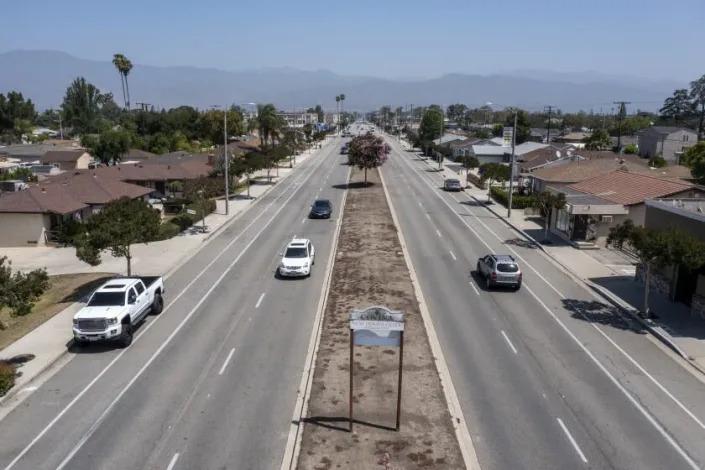
More than 6 million Southern Californians will be placed under new drought rules today in an effort to conserve water.
The Metropolitan Water District of Southern California has called for a 35% reduction in water use following California's driest-ever start to the year. The board of the MWD has never before issued such severe cuts, but they were left with little recourse after state officials slashed deliveries from the State Water Project to just 5%.
We have not had the supply to meet the normal demands that we have, and now we need to prioritize between watering our lawns and having water for our children and grandchildren.
According to the U.S. Drought Monitor, more than 98% of the state is currently under some type of dry spell. Many of the region's most critical reservoirs are half capacity or less.
Here is what you need to know about the new rules.
Who is affected?
The State Water Project supplies water to parts of Los Angeles, Ventura and San Bernardino counties that are dependent on supplies from the project.
The Los Angeles Department of Water and Power, the Inland Empire Utilities Agency, the Las Virgenes Municipal Water District, Calleguas Municipal Water District, Three Valleys Municipal Water District and Upper San Gabriel Valley Municipal Water District will be affected by the rules.
Several of those agencies are water suppliers.
Although the Colorado River is reaching critical lows, areas that get water from it have been spared for now.
What are the rules?
There is a patchwork of rules across the region because each agency takes a slightly different approach to achieving the required reduction. Half of all urban water use is accounted for by outdoor watering.
The entire service area of the Los Angeles Department of Water and Power is being limited to two-day-a-week watering.
Residents will be assigned watering days based on where they live. There will be no watering between 9 a.m. and 4 p.m.
The people who don't comply with the new rules will be warned and fined. LADWP patrols will look for people who are violating rules.
The Las Virgenes Municipal Water District is one of the agencies that is opting for one-day-a-week watering limits. The agency provides water to about 75,000 people.
The Inland Empire Utilities Agency and the Calleguas Municipal Water District are both wholesalers and are using each of their member agencies to institute the best plans for their areas. Some will go to one-day-a-week watering, while others will stick to their allocations based on available supplies.
Two-day-a-week watering limits are being called for by the West Basin Municipal Water District, which supplies water to residents in areas such as Malibu.
Is there any exceptions to the rules?
The DWP makes exceptions for hand- watering and for drip irrigation that supplies water to a food source.
What about golf courses?
They have stressed that they don't want trees to die, despite officials saying that Southern California can't afford green lawns. Trees provide shade and help with heat effects.
If the new restrictions are followed correctly, they shouldn't have an effect on trees.
Even the most delicate trees would be happy with eight minutes twice a week, and the larger trees will be happy with the occasional heavy watering by hand, according to a board certified master arborist.
Many people in the area have questions about swimming pools. The use of pool covers to prevent evaporation is not required by most water agencies.
The DWP said that the next phase of the law would make covering residential pools a requirement, while the final phase would prohibit filling them with water.
The California Pool & Spa is sending a mixed message, according to some residents. It makes sense that pools can help save water over time by replacing thirsty grass that would require constant watering, since the average pool requires up to 18,000 gallons of water to initially fill.
Some golf courses use recycled water, despite the fact that many residents point out that golf courses account for a huge amount of grass in the city. The courses that don't will have to work with the city to achieve the reduction targets.
People are being asked to save water wherever they can, including in the shower, because showers aren't officially in the crosshairs of the cuts. The state encouraged Californians to shorten their showers to five minutes and switch from baths which can use up to 2.5 times as much water.
What is the long-term plan?
The state could be forced to impose mandatory restrictions for the same reason as the MWD if they don't improve their water use.
While the new outdoor watering limits should help achieve immediate savings, some have pointed out that they are a short-term solution to a long-term problem.
During the L.A. City Council meeting last week, Paul Krekorian said that the climate change is not a temporary condition.
Improving infrastructure and water conveyance systems, as well as investing in enhanced capabilities for water recycling, are some of the solutions being worked on by city, county and state officials.
One major initiative is called "operation next", which aims to recycle as much as 100% of the wastewater from the water reclamation plant by the year 2035.
The state of California last week banned watering grass at commercial, industrial and institutional properties, and Los Angeles is investing heavily in turf replacement and appliance upgrades to improve water efficiency.
The vast majority of the state's water that is used by humans goes toward agriculture, as much as 80%, according to officials. Many farmers were put on notice that they will receive limited allocations from state and federal suppliers.
The story was originally published in the Los Angeles Times.